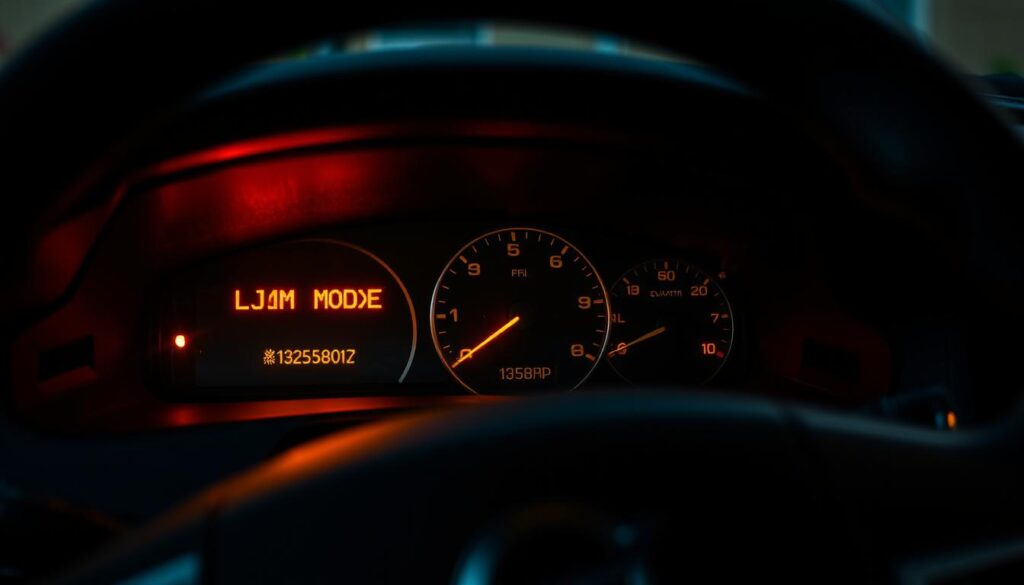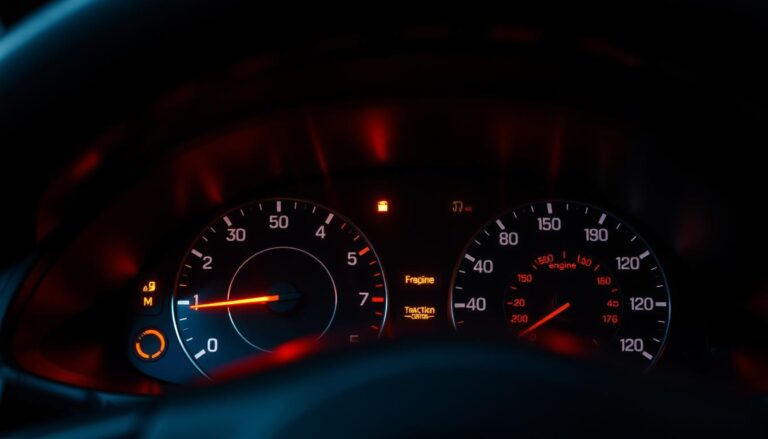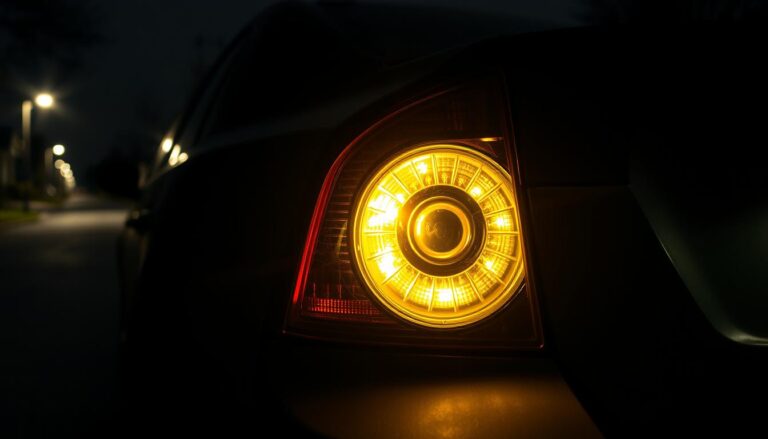This introduction explains what happens when a car enters limp mode and how drivers can respond. The protection strategy limits power so the vehicle remains driveable while the ECU or TCU prevents further damage. Typical signs are reduced acceleration, warning lights, and revs capped near 2,000–3,000 rpm.
On many automatics the gearbox locks in a low gear and top speed often stays around 30–50 mph. Common triggers include very low oil or coolant, transmission errors, brake faults, wiring loom issues, and engine misfires or turbo problems.
Try a safe reset by switching the ignition off for about 30 seconds, then restart. Battery terminal removal can also clear codes, but faults will usually return if the root cause is not fixed.
If the vehicle will not accelerate to traffic flow, multiple lights come on, or the engine sounds abnormal, stop and seek professional help. This guide uses clear examples and practical steps so you can decide on a DIY fix or call a qualified mechanic.
Key Takeaways
- Limp mode limits power so the car can reach a safe spot without severe damage.
- Look for reduced acceleration, capped revs, and warning lights as first signs.
- Simple resets may clear the fault temporarily; underlying issues need repair.
- Common causes include engine, transmission, wiring, and fluid problems.
- Seek immediate professional diagnosis if the vehicle is unsafe or multiple warnings appear.
Understanding Volvo limp mode right now: symptoms, safety limits, and why your car “goes limp”
A sudden drop in acceleration often signals the car has entered a protective state managed by engine and gearbox electronics. This safety mode reduces output so you can move to a safe spot without causing further damage.
How the ECU and transmission control protect components
Electronic control units limit revs and torque to reduce stress on critical parts. The transmission may lock into a low gear and the engine control will cap RPM near 2,000–3,000.
Common on-road signs
- Marked loss of throttle response and steady power reduction.
- Dashboard lights, sometimes multiple warnings, including ABS alerts.
- Top speed restricted—often near 30–50 mph—making highway merging unsafe.
Immediate roadside checks
Park safely, check oil and coolant levels, and inspect for fresh leaks. Avoid revving the engine.
“If warnings return after a quick key-off reset, record the lights and limits and arrange diagnostic testing.”
Volvo Limp Mode: What Causes It and How to Fix It
Begin diagnostics with a code scan; that reveals active errors and freeze-frame data.
Engine and turbo triggers include intake leaks, split intercooler hoses, faulty throttle body, misfires, or turbo control faults. These cause unmetered air or loss of boost and force the ECU into a protective setting that limits rpm and power.
Drivetrain and gearbox problems appear when the transmission control detects failed shifts or internal errors. The TCU reduces torque to protect clutches and gears. Quick scans often show transmission codes that need priority.

ABS, wiring, water risks, and checks
Corrupt wheel-speed sensor data or an ABS module fault can trigger reduced engine performance and traction limits. Damaged wiring looms, poor grounds, or wet connectors often cause erratic signals and stored fault codes.
Owners report module damage after clogged sunroof drains let water reach floor-mounted electronics. Check carpets, connectors, and the floor area for moisture or corrosion.
“Scan for active versus stored codes, inspect connectors, then address the highest-priority engine, transmission, ABS, or module fault.”
For a full list of error references use the fault codes list. If a brief key-off reset clears a warning but the condition returns, the underlying fault remains and needs repair.
Practical fixes for today: targeted repairs, cost-smart decisions, and when to call a mechanic
A few minutes of basic inspection can reveal obvious damage and clear common errors.
Quick DIY wins: Top up oil and coolant, reseat visible connectors, and look under the wheel hubs for debris or broken wiring. Check wheel-speed sensors for dirt or corrosion that may throw a code.

Addressing throttle valve codes
Clean the throttle plate using the right cleaner, check for intake leaks, then run the idle/throttle relearn. If a code returns or tests fail, plan on replacement with OEM calibration to avoid recurring engine limits.
ABS module and sensor repairs on S40 V50 XC models
Sensor swaps often fix ABS warnings. Persistent errors need module testing; repair ranges from sensor replacement to module refurbishment at a specialist center.
Moisture control
Clear sunroof drains from both roof channel and exit points. Lift wet carpets, dry the floorpan for several days, clean connectors, then protect terminals with dielectric grease.
“If limp mode returns after resets or multiple warnings appear, schedule professional diagnostics at a specialist center.”
| Issue | Typical DIY time | Likely cost range | Next step |
|---|---|---|---|
| Low fluids | 15–30 minutes | $10–$50 | Top up, recheck |
| Wheel-speed sensor | 30–90 minutes | $50–$200 | Clean or replace sensor |
| Throttle valve code | 30–120 minutes | $0–$600 | Clean, relearn, or replace |
| Moisture-damaged module | Days (drying) + repair time | $100–$1,000+ | Dry, test; repair or replace |
Cost-smart advice: Verify active codes before buying parts. If the vehicle enters limp mode after rain, hunt leaks first rather than chasing secondary codes.
Conclusion
strong, A sudden cap on rpm and speed should prompt a calm, step-by-step inspection and diagnostic scan.
Recap: This protective mode limits power and top speed so the car avoids major damage. Treat the event as a safety net and a clear sign that a fault needs resolving.
Focus on root causes: scan for active codes, check for low oil or coolant, inspect wiring and look for recent water ingress after heavy rain. Simple resets may clear lights briefly, but deeper fixes restore full performance.
Next steps: Record exact messages and behaviour, perform safe restarts, then tackle basic checks before moving on to targeted repairs. If safe mph cannot be held or multiple lights show, seek professional help.
FAQ
What does limp mode mean and how does the engine control unit protect my car?
The ECU limits power and speed when it detects a serious fault to prevent engine or gearbox damage. It reduces throttle response, caps RPM and sometimes forces a single gear so you can reach a safe stop or a repair shop without worsening the issue.
Which on-road signs tell me the car has gone into reduced-power mode?
Look for sudden loss of acceleration, a fixed low top speed (often 30–50 mph), hard-to-change gears, and warning lights such as the check engine or transmission lamp. You may also notice rough idling or a drop in turbo boost on forced-induction engines.
Can I still drive when the vehicle is in this state, and how far safely?
Yes, you can usually drive slowly to a nearby safe location or workshop. Keep speeds low, avoid highway travel, and stop if knocking, heavy smoke, or fluid leaks appear. The system aims to let you move without causing further harm.
What quick checks can I perform at the roadside to try a safe reset?
Pull over, switch off the engine, check oil and coolant levels, scan for obvious fluid leaks, and inspect under the car. Sometimes a key-off wait and restart clears a temporary fault. If the issue returns immediately, don’t continue driving.
Which engine and turbo faults commonly trigger reduced-power protection?
Misfires, failed ignition coils, clogged air intake, massive air leaks, faulty mass airflow or MAP sensors, and turbo wastegate or boost-control failures are frequent causes. Any condition risking overheating or severe detonation can trigger intervention.
How do transmission or gearbox faults force the system into a safe state?
Gearbox sensors, solenoids, pressure loss, or bad clutch packs can prompt fault codes that limit gear selection and torque. The car will often default to a single gear to protect the transmission from catastrophic failure.
Can ABS or traction control problems cause the car to go into restricted mode?
Yes. Faulty wheel-speed sensors, ABS module errors, or broken wiring can send incorrect signals that affect engine management or transmission logic. The system may limit power to avoid unsafe traction and control conditions.
How do electrical issues and wiring faults lead to reduced performance warnings?
Damaged harnesses, corroded connectors, poor grounds, or failing control modules create intermittent or permanent faults. Modules detect inconsistent data and trigger fail-safe restrictions to protect drivetrain components.
How does water ingress affect modern cars and trigger these faults?
Water in footwells, soaked carpets, or clogged sunroof drains can reach floor-mounted modules and connectors. Moisture causes corrosion and shorts that produce erratic sensor readings or permanent failures, prompting protective modes.
What is the step-by-step diagnostic approach technicians use?
Start with an OBD-II scan to read active and stored trouble codes, freeze-frame data and live sensors. Inspect wiring, connectors, and grounds for affected circuits. Perform component tests (sensors, coils, solenoids) and confirm whether faults are intermittent or permanent.
Will a simple reset always fix the problem, and what reset methods exist?
Temporary resets (key cycle, disconnect battery for a few minutes, or use a scanner clear) can clear transient faults, but persistent issues return. A reset only removes the symptom; you must repair the root cause to prevent recurrence.
What DIY tasks can help before visiting a workshop?
Check and top up oil and coolant, inspect visible wiring and connectors for corrosion or water, clean and reseat major plugs, and visually check wheel-speed sensors for debris. These steps can solve minor faults or at least narrow down the cause.
How should I approach throttle-body or throttle-valve trouble?
Try cleaning the throttle body and performing any required relearn procedures first. If codes persist, the throttle actuator or position sensor may need replacement. Relearn is often necessary after battery disconnect or component changes.
What can I expect when repairing ABS modules or wheel sensors on S40, V50, or XC models?
Costs vary by part and labor. Wheel sensors are usually inexpensive and simple. ABS module replacement or repair is more involved and may require module coding or software updates. Expect diagnostic time plus potential module refurbishment fees.
How do I prevent moisture-related problems in the future?
Keep sunroof drains clear, ensure door and trunk seals are in good condition, dry carpets promptly, and avoid leaving wet items inside. Regular inspections and protecting floor-mounted electronics with dielectric grease help reduce corrosion risk.
When is it time to call a professional mechanic versus continuing DIY troubleshooting?
Call a pro when codes point to internal transmission faults, repeated active engine misfires, module failures, or when safety systems like ABS and traction control refuse to reset. Complex electrical or gearbox repairs need workshop tools and experience.



